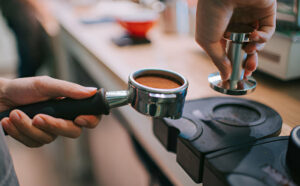-
Empty cart
No products in the cart.
Return to Shop

10 Must-Have Essentials for Perfect Espresso Coffee
Brewing the perfect espresso at home starts with having the right tools. Each piece of equipment plays a vital role in crafting a rich, flavorful

When evaluating espresso, some believe that more crema indicates higher bean quality. But is this truly the case? What exactly is crema, and what does it signify about coffee? Can we determine a properly extracted espresso solely from its crema? And how should one consume crema?
Crema is seen by some as a mark of a good espresso, the foundation of Italian espresso. Others, however, consider it an unimportant byproduct of the extraction process.
So, how is crema formed?
James Hoffmann, in “The World Atlas of Coffee,” explains that under pressure, water dissolves more carbon dioxide (CO2) derived from coffee roasting. When the brewed liquid returns to normal atmospheric pressure in the cup, these gases can’t remain dissolved, forming countless tiny bubbles—a stable foam.
Britta Folmer, author of “The Craft & Science of Coffee,” emphasizes that pressure is crucial for crema formation. Pressure pushes CO2 from ground coffee into the water, gradually releasing it, creating a dense and stable oily layer atop the coffee.
Note: Pour-over methods can’t create crema due to the necessary pressure.
From a Barista’s View:
Crema signifies freshness but doesn’t entirely reveal the flavor profile of the beans. Tasting is essential.
Steven Moloney, two-time Swedish Barista Champion, clarifies that crema doesn’t directly correlate with well-extracted Italian espresso. Even poorly roasted beans can yield beautiful, dense crema, but the taste might suffer.
From a Consumer’s View:
In a 2015 study by Nespresso, consumers expected better quality from espresso with visually appealing crema. It heightened their anticipation for a smoother and better-tasting coffee experience.
When consumers say: "I want a strong cup of coffee." Consumers want: coffee that tastes bitter or is fully bodied. The barista thinks: a coffee with a higher extraction strength.
Quick Q&A:
Does longer extraction mean more crema?
No! Longer extraction makes crema lighter in color.
Does longer extraction mean higher coffee concentration?
Yes! Caffeine levels increase too.
Can highly extracted espresso taste light?
Yes! High extraction doesn’t necessarily mean intense flavor.
Does coarser grinding result in lower coffee concentration?
Yes!
Is crema’s taste profile different from espresso’s?
Yes! Experiment with various extraction profiles.
Usually perceived as more bitter than espresso, some experts argue that separate consumption reveals crema’s sweetness.
Tips for Consumption: Skimming: Removing some crema reduces ashy bitterness, offering a cleaner taste and a sweeter espresso. Stirring: Stirring crema into espresso blends their flavors, offering a balanced taste.
Balance in extraction varies—some brands aim for a balance of acidity, sweetness, and bitterness.
Understanding variables (timing, temperature, coffee variety) and their effect on crema:
Identifying crema: Coarser or thinner texture, darker or lighter color, creamier or bubblier appearance.

Brewing the perfect espresso at home starts with having the right tools. Each piece of equipment plays a vital role in crafting a rich, flavorful

Hey there, fellow coffee aficionados! Have you ever witnessed the mesmerizing dance of espresso flowing freely from a bottomless portafilter? If not, prepare to be

If you’ve ever made espresso, you’ve probably heard the tip to press the coffee powder hard with a coffee tamper to ensure a good extraction.

What You Should and Shouldn’t Know About Cold Brew and Caffeine. What is Cold Brew Coffee? You’re probably familiar with cold brew coffee
Copyright 2024 © All rights Reserved. Design by EspressoFree

How can we help you?